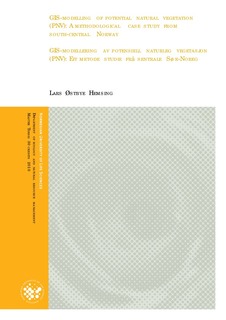GIS-modelling of potential natural vegetation (PNV) : a methodological case study from south-central Norway
Master thesis
Permanent lenke
http://hdl.handle.net/11250/186684Utgivelsesdato
2010-12-03Metadata
Vis full innførselSamlinger
- Master's theses (INA) [593]
Sammendrag
Potential natural vegetation (PNV) is a hypothetic natural state of vegetation that shows nature’s biotic potential in the absence of human influence and disturbance. By comparing PNV with actual vegetation, anthropogenic influences can be assessed and quantified. Actual vegetation in a mid-south Norwegian mountain region, located around the village of Beitostølen in Valdres, was mapped during fieldwork in summer 2009. This vegetation map formed the basis for the development of PNV using three different modelling methods. The purpose was to explore the different methods and attempt to locate anthropogenic disturbances. The first method was based on an expert-valuated manual mapped PNV map (PNVE) created simultaneously while mapping actual vegetation. The second model was created as a rule-based envelope GIS model (RBM), while the third model was created with a statistical predictive GIS modelling method, Maxent. RMB and Maxent were created with a basis in actual vegetation in addition to environmental predictor variables.
All models predicted the same vegetation types for 61% of total area, while different vegetation types were only predicted for 2% of total area. PNVE and Maxent were the two methods with highest accordance (87% of total area). Differences among modelling outputs were related to determine the upper potential forest limit for dominating tree species (birch and spruce), to model PNV for areas which are moderately to heavily disturbed by humans (e.g. farmland, housing estates, drained forests/swamps), and to model vegetation types that occur in their ecological extremities (e.g. humid types, rich types, successional state). The general tendencies for all three PNV models show a considerable increase and elevation of spruce forest, with a stable amount of birch forest, and decreasing amounts of boreal heath and meadow communities. Areas with boreal heath and meadow communities are transformed into mountain birch forest, whereas birch forest at lower altitudes is transformed into spruce forest.
PNV maps and actual vegetation maps were compared to reveal traces of earlier human disturbance; areas where vegetation types differed were considered as anthropogenically disturbed. All models predicted that more than 50% of vegetation from the actual vegetation map would be prevented from reaching its biotic potential. PNVE was the only model which captured human disturbance above the upper potential forest limit in the PNV maps. Shifts in forest distribution are known to be one of the major consequences of land-use changes in mountain areas. Potensiell naturleg vegetasjon (PNV) er ein hypotetisk naturleg tilstand som vegetasjon syner
naturens biotiske potensiale, forutsett at menneskeleg påverknad og forstyrring aldri har funne
stad. Ved å samanlikne PNV og aktuell vegetasjon kan menneskeleg påverknad verta kartfesta
og kvantifisert. Aktuell vegetasjonen vart kartlagt gjennom feltarbeid sommaren 2009. Dette
vegetasjonskartet danna grunnlaget for seinare utvikling av PNV kart ved hjelp av tre ulike
tilnærmingar for ein sentral Sør-Norsk fjellregion, lokalisert rundt Beitostølen i Valdres.
Hensikta var å undersøkje ulike tilnærmingar, og forsøkje å kartfesta menneskeskapte
forstyrringar av naturen. Første tilnærming er basert på eit ekspert evaluert, manuell kartlagt
PNV kart (PNVE) som vart danna fortløpande med kartlegging av aktuell vegetasjon. Den
andre tilnærminga er danna som ein regelstyrt konvolutt-modell (RBM) i GIS, medan den
tredje tilnærminga er oppretta med ein statistisk prediktiv GIS-modellerings metode, Maxent.
Dei to GIS-modellane vart danna på grunnlag av aktuell vegetasjon og miljøvariablar.
Alle tilnærmingane predikerte same vegetasjonstyper for 61% av det totale areal, medan berre
2% av totalt areal vart predikert med ulike vegetasjonstypar. PNVE og Maxent var dei to
tilnærmingane med høgast samsvar (total 87% av areal). Skilnadar mellom
tilnærmingsmåtane var knytta til fastsetjing av øvre potensielle skoggrense for dominerende
treslag (bjørk og gran), til å lage PNV for område som er moderat til sterkt forstyrra av
menneskeleg endringar (t.d. jordbruksområder, boligfelt, drenerte skogar/myrar) og til å
predikera vegetasjonstypar som førekjem i deira økologiske ytterpunkt (t.d fuktige typar, rike
typar, ulike suksesjonsstadium). Generelle trendar for alle PNV tilnærmingane syner ei
tydeleg auke i mengd og auke av granskogen, med stabil arealmessig mengde bjørkeskog, og
ein betydeleg reduksjon av boreale lyngheiear, og boreale engsamfunn. Område med boreale
lyngheiar og engamfunn blir omdanna til fjellbjørkeskog, medan bjørkeskogen ved lågare
høgder vert omdanna til granskog.
PNV kart og aktuellt vegetasjonskart vart samanlikna for å avdekke tidligere menneskeleg
forstyrring. Område som førekom med ulike vegetasjonstypar vart sett på som påverka av
menneskelege forstyringar. Alle tilnærmingar predikerte at meir enn 50% av vegetasjon frå
gjeldande vegetasjonskart vart forhindra frå å nå sitt biotiske potensial. PNVE var den eineste
modellen som fanga opp menneskelege forstyrringar ovanfor øvre potensial skoggrensen i
PNV karta. Endringar i skogfordelinga er kjent som ein av dei største konsekvensane av
arealbruksendringar i sørnorske fjellområde.
Beslektede innførsler
Viser innførsler beslektet ved tittel, forfatter og emneord.
-
Effect of vegetation encroachment on Macrotermes subhyalinus (Rambur) activity and associated mound vegetation, in Lake Mburo National Park,Uganda
Olsen, Marte (Master thesis, 2016-08-31)Termites play a key-role in the savanna ecosystem. As primary producers and decomposers, they transport soil nutrients vertically and horizontally, creating a more heterogeneous landscape. Increased canopy cover will shade ... -
Environmental and health impacts of pesticide use practice in vegetable production in Karatu and Arumeru districts, Tanzania
Ayano-Negawo, Tesfaye (Master thesis, 2016-08-11)Vegetable production is an important part of local economic growth and export earnings in Tanzania. The government of Tanzania is encouraging vegetable products due to favorable condition and increasing demands. Vegetables ... -
Calibration of the EU-Rotate_N model with measured C and N mineralization from potential fertilizers and evaluation of its prediction of crop and soil data from a vegetable field trial
Øvsthus, Ingunn; Thorup-Kristensen, Kristian; Seljåsen, Randi; Riley, Hugh; Dörsch, Peter; Breland, Tor Arvid (Peer reviewed; Journal article, 2021)
